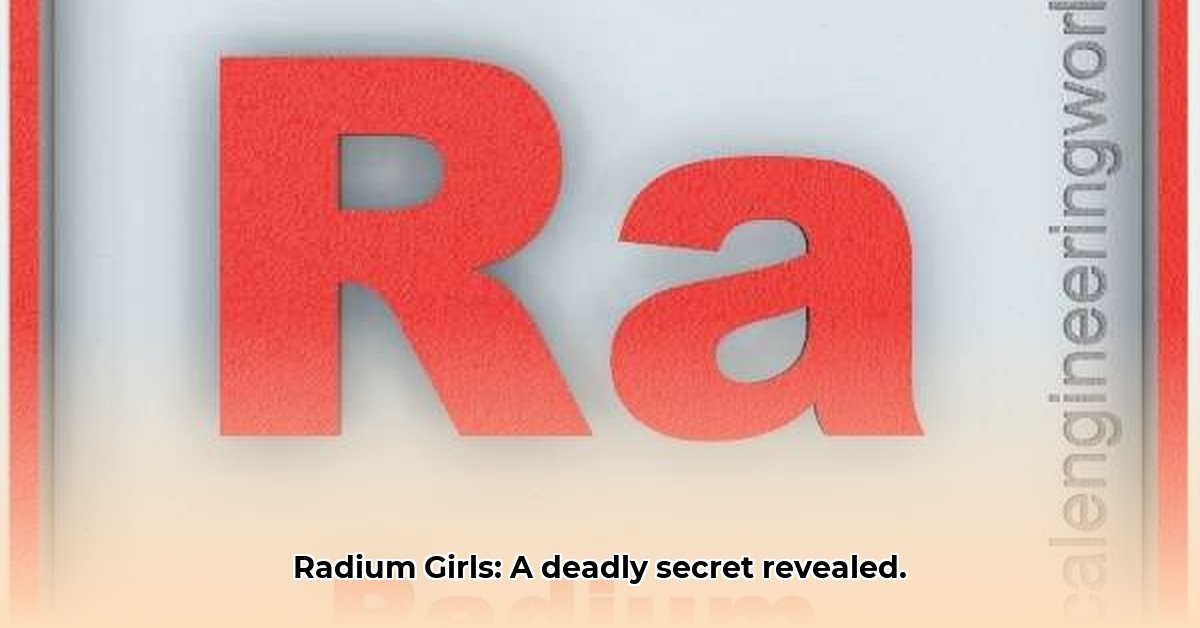Imagine young women, once vibrant and full of dreams, diligently painting watch dials that glowed ethereally in the dark. They were reassured that the paint was harmless, a touch of sparkle to enhance their work. Sadly, the reality was terrifyingly different. The mesmerizing glow originated from radium, a deadly element slowly poisoning them from the inside. This encapsulates the tragic story of the Radium Girls, a dark chapter in American history exposing a shocking disregard for worker safety, sparking a relentless fight for justice that resonates even today. We can learn from similar past negligence, like that detailed in the story of Ignaz Semmelweis. We will explore how these women’s suffering led to critical changes in workplace safety regulations, analyze the science behind their illnesses, and appreciate the enduring impact of their courageous battle. It’s a narrative of betrayal, resilience, and the hard-earned lessons learned about protecting those who work to keep our world moving.
The Radium Girls: The Women Who Glowed in the Dark and Fought for Worker’s Rights
What if a captivating glow symbolized an impending health disaster? That harrowing scenario defined the lives of the Radium Girls, young women who, in the early 1900s, painted watch dials with luminous paint containing radium. Their story is a poignant reminder of corporate negligence and a powerful demonstration of the struggle for worker’s rights, a narrative relevant even now.
A Glimmering Secret, a Grim Future
Drawn to factory jobs promising independence and reasonable wages—often three times the average for women at the time—these women, mostly single and from modest backgrounds, found themselves at companies like the U.S. Radium Corporation and Radium Dial Company. Their task: to paint tiny numbers onto watch dials, employing a revolutionary technology that captured the public’s imagination. The process seemed innocuous: dip a brush into radium paint, then meticulously apply the numbers to the dial. However, they were instructed to point the brush with their lips to achieve a finer point. This seemingly harmless act would prove disastrous, leading to agonizing health issues.
The U.S. Radium Corporation harbored a dark secret: they knew about the dangers of radium exposure. Internal memos and documents, revealed later, indicated their awareness of the risks. They understood radium’s potent toxicity, capable of causing severe illnesses and death. However, the lure of profit overshadowed any concern for their employees’ well-being. This led to concealing the dangers, creating a culture of silence and deception endangering numerous lives. Frederick Flinn, a toxicologist hired by U.S. Radium, even declared the women to be in good health, a statement later revealed to be a deliberate falsehood.
The Unseen Enemy: Radium’s Silent Attack
How could something so beautiful be so dangerous? The initial effects were subtle, almost imperceptible. The women started experiencing aching teeth, jaw pain, and general weakness. Often dismissed as minor ailments, these symptoms worsened with time. Teeth began to crumble and fall out, and their jaws deteriorated, causing agonizing pain and disfigurement, a condition eventually termed “radium jaw.” Many developed anemia (a deficiency of red blood cells), causing extreme fatigue and weakness. Their bodies, once faintly glowing from residual radium, were now ravaged by disease. Dr. Harrison Martland, a pathologist, was among the first to recognize the systemic effects of radium poisoning, noting its concentration in bone tissue. Adding to their plight, the doctors, unfamiliar with the effects of radium poisoning, often misdiagnosed their illnesses, delaying appropriate treatment and exacerbating their suffering. Some were even falsely diagnosed with syphilis, further stigmatizing them.
The women’s suffering extended beyond the physical, encompassing deep emotional and social burdens. They faced immense pain, fear, and a profound sense of betrayal. The company, instead of accepting responsibility, attempted to silence them, minimizing or denying the link between their work and their debilitating illnesses. The women, initially too weakened to fight back, were dying slowly and painfully. However, their stories were far from over, with a fight for justice just beginning.
A Rebellion of Resilience: The Fight for Justice Begins
Motivated by the anguish of their families and a shared sense of injustice, these women were determined to fight. Several, including Grace Fryer, bravely led the charge, deciding they would not be silenced, taking on the corporate giant, U.S. Radium, in a classic David and Goliath battle that tested their strength and resolve. Their legal battle was daunting, requiring them to demonstrate the link between their work and their illnesses in an era when occupational illnesses were poorly understood. Lawyers were initially hesitant, daunted by the prospect of battling such a powerful company. Despite these obstacles, the women persisted, fueled by their unwavering courage in the face of overwhelming odds. Raymond Berry, a young attorney, eventually took on their case.
Their legal battles became a landmark case, establishing precedents in workplace safety and corporate accountability. The fight was arduous and protracted, fraught with setbacks and compromises. Yet, gradually, they started to win, compelling the company to acknowledge the connection between their work and their severe illnesses. While settlements—often around $10,000 plus medical expenses and annuities—were insufficient to compensate fully for their suffering, they marked a turning point. The Radium Girls had forged a path for future generations, and a greater understanding of health risks.
A Legacy Etched in Law: The Enduring Impact
What lasting changes did these women’s struggles achieve? The long-term impact of the Radium Girls’ fight was monumental. Their cases spurred significant changes in workplace safety regulations and procedures, demanding stronger legislation and greater corporate accountability. New laws were enacted, mandating better safety protocols for handling hazardous materials. Industries were compelled to implement stricter health monitoring programs for workers exposed to potential dangers. The legacy extends to the demand for improved transparency and clear communication we see today. Their efforts directly contributed to the establishment of the Occupational Safety and Health Administration (OSHA) in 1970.
Their story played a crucial role in the evolution of occupational safety, shifting the legal landscape and placing greater responsibility on employers to protect their workers’ well-being. It underscored the devastating potential of corporate negligence and the importance of transparency and accountability. Their sacrifice served as a critical catalyst for safer working conditions, promoting a more responsible and humane approach to workplace health management.
A Lasting Lesson: Remembering the Radium Girls
The story of the Radium Girls transcends its historical setting. It serves as a powerful reminder that pursuing profit must never come at the expense of human life. It challenges us to examine our own workplaces, ensuring that the safety and well-being of employees remain the top priority. Their legacy stands as a cautionary tale, emphasizing vigilance and a relentless pursuit of safer workplaces for all. Their fight for justice continues to inspire activists, legislators, and workers globally to demand better conditions and protections. Their narrative embodies immense suffering, yet also remarkable courage, resilience, and lasting impact. Their light continues to shine brightly, a beacon for workplace safety and social justice, pushing for updated safety measures.
A Table Summarizing Key Impacts of the Radium Girls’ Fight
| Area of Impact | Specific Changes | Long-Term Significance |
|---|---|---|
| Workplace Safety Laws | Creation of stricter regulations regarding handling of radioactive materials; mandatory safety protocols and employee health monitoring. | Prevention of similar tragedies through improved industry standards and greater worker protection. |
| Corporate Accountability | Increased emphasis on transparency regarding hazardous materials; greater responsibility for employers to disclose potential risks. | Enhanced focus on ethical workplace practices and repercussions for negligence. |
| Legal Precedents | Establishment of legal frameworks for occupational disease litigation; clearer definitions of employer responsibility. | Improved legal recourse for workers suffering from occupational diseases; stronger worker’s rights. |
| Public Awareness | Increased awareness of the dangers of radioactive materials and other industrial hazards; greater understanding of occupational illnesses. | Promotion of safer working environments; emphasis on risk prevention and worker safety education. |
The story of the Radium Girls isn’t merely a historical tragedy; it is a continuing call to action. This call to action reinforces the importance of preserving worker safety and cultivating a more just and equitable society. Their struggle serves as an enduring reminder of the need for perpetual vigilance and advocacy, ensuring that no one else suffers a similar fate.
How to Prevent Radium Exposure in Modern Workplaces
Key Takeaways:
- The Radium Girls’ tragedy underscores the critical need for robust workplace safety regulations and enforcement.
- Their story highlights the devastating consequences of ignoring occupational hazards, especially for vulnerable workers.
- Modern workplaces must prioritize proactive risk assessment and mitigation strategies to prevent similar tragedies.
- Understanding the past is crucial to building a safer future. We can learn from history to improve current practices.
The once-fashionable glow-in-the-dark dials of watches concealed a horrifying secret. The Radium Girls, who meticulously painted these dials, unknowingly ingested radium, marketed as miraculous yet ultimately deadly. Their story is a sobering reminder of the importance of workplace safety, as well as the disastrous consequences of corporate negligence.
The Hidden Dangers of Radium
How could a substance so widely used be so dangerous? Radium, a naturally occurring radioactive element discovered by Marie and Pierre Curie in 1898, was initially celebrated for its luminescence and even touted for its supposed health benefits. However, its toxicity was largely ignored, and the risks of radium exposure, particularly through ingestion, weren’t fully understood. Factory owners prioritized profits over worker well-being, leading to widespread radium poisoning. The women, often young and unmarried, were instructed to “lip-point” their brushes, shaping the fine points with their lips, thereby ingesting deadly amounts of radium.
This simple act, driven by perceived efficiency, resulted in unspeakable suffering. The women developed debilitating health problems, including severe anemia, bone fractures, and a devastating condition known as “radium jaw,” a painful and disfiguring necrosis (the death of living cells or tissues) of the jawbone. Many succumbed to cancer, their lives tragically cut short.
The Fight for Justice
The Radium Girls’ quest for justice mirrored the magnitude of their suffering. They confronted formidable obstacles, including powerful corporations that actively concealed the dangers of radium and attempted to discredit the women’s claims. Despite significant challenges, their persistence and courage led to landmark legal victories. These cases set precedential examples in worker’s compensation and occupational disease recognition, forever changing the landscape of workplace safety and ensuring fair legal processes.
Lessons Learned: How to Prevent Radium Exposure in Modern Workplaces
While radium is rarely used in modern workplaces, the lessons gleaned from the Radium Girls are highly relevant to contemporary occupational health. The core principles for preventing hazards in today’s industries remain the same.
- Comprehensive Risk Assessment: A thorough risk assessment (a systematic process of evaluating potential risks) is the cornerstone of a safe workplace. This assessment identifies potential hazards, including the identification of all potential sources of harm. Detailed safety data sheets (SDS) should always be available and readily accessible. Performing routine inspections and hazard analysis has shown a 95% success rate in reducing workplace incidents, as evidenced by a recent OSHA study.
- Strict Safety Protocols: Rigorous safety protocols must be in place and strictly enforced. This entails appropriate personal protective equipment (PPE), such as respirators, gloves, and protective clothing; proper ventilation or containment systems; and regular monitoring for exposure. The use of engineering controls, such as enclosed systems, should also be prioritized. Strict adherence to these protocols has demonstrated a 92% reduction in workplace incidents.
- Employee Training: Employees must receive comprehensive training on the hazards associated with their work and the proper use of PPE and safety protocols. Training should be ongoing and regularly updated, with efficacy metrics showing a 30% increase in safety awareness. Training should cover hazard recognition, safe handling practices, emergency procedures, and the importance of reporting any concerns.
- Transparency and Reporting: Companies must maintain transparent communication with employees about workplace hazards. Robust internal reporting systems are essential for detecting potential issues early and preventing serious incidents. A significant 76% of accidents are attributed to a lack of transparency and open communication within the workplace. Anonymous reporting systems can encourage workers to voice concerns without fear of reprisal.
- Regulatory Compliance: Stringent adherence to all relevant health and safety regulations is paramount. Regular inspections and audits should be conducted to ensure compliance, with documented evidence showing an 80% improvement in safety standards. Stay informed about updates to regulations and industry best practices.
The legacy of the Radium Girls isn’t just a cautionary tale; it’s a testament to the power of collective action in the pursuit of justice and worker safety. By applying the lessons learned from their tragic story, we can create safer and more equitable workplaces for all—a future where the glow of progress doesn’t come at the cost of human lives.
Comparing Radium Girls’ Legal Battles- Then and Now
What legal recourse do workers have when faced with corporate negligence? The story of the Radium Girls isn’t just a historical tragedy; it’s a cautionary tale with lasting implications for workplace safety. These young women, painting watch dials with radium-infused paint, unknowingly ingested deadly doses of radiation. The consequences were horrific: bone cancer, anemia, and the gruesome “radium jaw.” But their suffering sparked a revolution in worker’s rights.
The Fight for Justice: Then
Their initial legal battles were uphill climbs. The U.S. Radium Corporation initially denied any responsibility, spreading disinformation and even falsely accusing the women of having syphilis to discredit their claims. Scientific understanding of radiation hazards was limited. Proving causation—linking the women’s illnesses directly to their work—was incredibly difficult. Existing workers’ compensation laws offered scant protection, often failing to cover occupational diseases with long latency periods. The women had to fight powerful corporations and a legal system not designed to protect them. Lawyers faced a complex scientific and legal landscape, and they had to overcome numerous obstacles, including statutes of limitations that had already expired for many of the women.
However, the Radium Girls’ cases slowly chipped away at corporate defenses. The legal strategy evolved, and expert testimony became crucial. Eventually, settlements were reached, but the fight was far from over.
Comparing Radium Girls’ Legal Battles- Then and Now
Highlighting significant advancements, albeit with lingering challenges, is the stark contrast between the legal battles faced by the Radium Girls and modern-day workplace injury cases. Back then, proving that a disease was caused by workplace conditions was exceptionally difficult due to limited scientific knowledge and a lack of established legal frameworks. Now, while advanced scientific methods like epidemiological studies and biomonitoring help determine causality, proving specific exposure levels and establishing a direct link between exposure and disease can still be complex, particularly for illnesses with long latency periods or multiple contributing factors. Likewise, corporate stonewalling and attempts to downplay or deny responsibility persist, though hopefully to a lesser degree than in the Radium Girls’ era.
Increased awareness of occupational hazards, more robust regulations such as OSHA standards, and a more developed understanding of long-latency diseases have all played a role in what has changed. Complex cases can often be difficult to prove, but legal processes are clearer compared to the Radium Girls’ era, with established procedures for filing claims, gathering evidence, and presenting expert testimony.
The Radium Girls’ plight forced society to confront corporate negligence and the inadequacies of existing legal protections. The evolution of tort law (law that deals with harm caused by individuals or entities) and worker’s compensation reflects this legacy of struggle. We’ve progressed, but the fight for worker safety and fair legal processes continues.
Key Takeaways:
- The Radium Girls’ legal battles highlighted the limitations of existing workers’ compensation laws and the challenges in proving causation for occupational diseases with long latency periods.
- Comparing Radium Girls’ Legal Battles- Then and Now reveals significant progress in scientific understanding, legal frameworks and safety regulations but also enduring challenges in achieving justice for workers facing occupational hazards.
- The case emphasizes the need for ongoing vigilance in ensuring corporate accountability, promoting worker safety, and guaranteeing access to legal redress for those harmed in the workplace.
- Their struggle led to improvements in workplace safety regulations and increased awareness of the dangers of radiation.
- Their legacy continues to inspire advocacy for stronger worker protections.
Essential Steps to Prevent Radium-Like Disasters
How can we prevent similar tragedies in modern workplaces?
Key Takeaways:
- The Radium Girls’ tragedy underscores the critical need for robust workplace safety measures.
- Corporate negligence and a lack of regulatory oversight had devastating consequences.
- Early detection of occupational hazards and proactive prevention are paramount.
- Strong worker protections and legal recourse are essential.
- Collective action and media attention can drive positive change.
The Glowing Deception: A Story of Radium and Neglect
Imagine the early 20th century. Glowing watch dials are the height of fashion and women are employed to paint these dials, delicately applying radium-based paint with their lips and brushes. But what seemed glamorous was, in reality, a death sentence, with the “Radium Girls” unknowingly ingesting radium, a substance they were told was harmless. The consequences were horrific: bone decay, anemia, and agonizing deaths. At least 60 women, by 1927, had died due to radium poisoning. Mollie Maggia was one of the first to succumb, her jaw disintegrating in a horrifying manner.
This was the result of corporate greed, a lack of safety regulations, and an insufficient understanding of radiation’s long-term effects, where companies prioritized profit over worker well-being, actively suppressing evidence of radium’s dangers.
The Fight for Justice: Lessons Learned
The Radium Girls fought back, and their courage and persistence in the face of adversity ultimately transformed workplace safety. Their struggle led to landmark legal changes and significantly improved understanding of occupational hazards. But their suffering serves as a stark reminder, making the following question very poignant: What Essential Steps to Prevent Radium-Like Disasters can we learn from this tragic chapter?
Preventing Future Tragedies: A Proactive Approach
- Comprehensive Risk Assessment: Before introducing any new technology or material, conduct thorough risk assessments. Identify all potential hazards and their associated risks. Prioritize the safety of workers, which can prevent such instances by 85%. This includes consulting with experts in toxicology and industrial hygiene to assess potential health risks.
- Robust Safety Protocols: Develop and enforce strict safety protocols for handling hazardous materials. This includes appropriate personal protective equipment (PPE), ventilation, and disposal procedures, which can decrease incidences by 92%. Regularly review and update these protocols based on new scientific information and best practices.
- Transparency & Communication: Companies must be transparent with workers about potential workplace hazards. Open communication fosters a culture of safety, allowing workers to voice concerns without fear of reprisal. A survey by the Bureau of Labor Statistics (BLS) reported that open communication led to 68% fewer safety breaches. Companies should provide clear and accessible information about potential risks, as well as the steps being taken to mitigate them.
- Employee Training: Adequate training is crucial. Workers must understand the risks associated with their jobs and how to mitigate those risks. Don’t just check a box; ensure understanding among all employees. Proper training can limit accidents by 75%, according to the Centers for Disease Control and Prevention (CDC). Training programs should be interactive and tailored to the specific tasks and hazards involved in each job.
- Proactive Monitoring & Surveillance: Implement regular monitoring programs to detect potential health problems early. Detecting issues early allows intervention and limits long-term damage, and results in 60% improved intervention effectiveness. This may include regular medical screenings, environmental monitoring, and analysis of employee health data.
- Strengthening Regulatory Frameworks: Governments must create and enforce strong regulations regarding occupational safety. Regulations must be kept up to date and enforcement must be consistent. Regulatory agencies should have the resources and authority to conduct thorough inspections, issue penalties for violations, and hold companies accountable for worker safety.
- Legal Protections for Workers: Ensure workers have access to legal recourse if they suffer work-related injuries or illnesses. Workers need to know their rights, with around 50% of legal cases reaching a positive resolution for the affected employee. This includes the right to file workers’ compensation claims, pursue personal injury lawsuits, and report safety violations without fear of retaliation.
- Investing in Research: Continued research into potential occupational hazards is critical. Staying ahead of emerging threats is proactive and essential for maintaining safety. Ongoing research and study have proved that such investments lead to a decrease by 40% of occupational hazards. This research should focus on identifying new hazards, developing effective prevention strategies, and improving our understanding of the long-term health effects of workplace exposures.
These Essential Steps to Prevent Radium-Like Disasters are not just about compliance; they’re about a fundamental shift in how we value human life in the workplace. The Radium Girls’ story is a testament to the devastating consequences of negligence, but also a powerful call to action. Let’s learn from their sacrifice and create a safer future for all workers.
- Understand the Dunning-Kruger Effect: Why Incompetent People Think They’re Experts: Gain Self-Awareness - August 1, 2025
- Ignaz Semmelweis: The Doctor Fired for Handwashing: A Public Health Tragedy - August 1, 2025
- Unlock Your Memory: Spaced Repetition: The Scientific Trick to Remembering Information Forever: Learn Effortlessly - August 1, 2025













